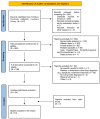Candidate Biological Markers for Social Anxiety Disorder: A Systematic Review
- PMID: 36614278
- PMCID: PMC9821596
- DOI: 10.3390/ijms24010835
Candidate Biological Markers for Social Anxiety Disorder: A Systematic Review
Abstract
Social anxiety disorder (SAD) is a common psychiatric condition associated with a high risk of psychiatric comorbidity and impaired social/occupational functioning when not promptly treated. The identification of biological markers may facilitate the diagnostic process, leading to an early and proper treatment. Our aim was to systematically review the available literature about potential biomarkers for SAD. A search in the main online repositories (PubMed, ISI Web of Knowledge, PsychInfo, etc.) was performed. Of the 662 records screened, 61 were included. Results concerning cortisol, neuropeptides and inflammatory/immunological/neurotrophic markers remain inconsistent. Preliminary evidence emerged about the role of chromosome 16 and the endomannosidase gene, as well as of epigenetic factors, in increasing vulnerability to SAD. Neuroimaging findings revealed an altered connectivity of different cerebral areas in SAD patients and amygdala activation under social threat. Some parameters such as salivary alpha amylase levels, changes in antioxidant defenses, increased gaze avoidance and QT dispersion seem to be associated with SAD and may represent promising biomarkers of this condition. However, the preliminary positive correlations have been poorly replicated. Further studies on larger samples and investigating the same biomarkers are needed to identify more specific biological markers for SAD.
Keywords: biological markers; neuroimaging; social anxiety disorder; social phobia; systematic review.
Conflict of interest statement
The authors declare no conflict of interest.


